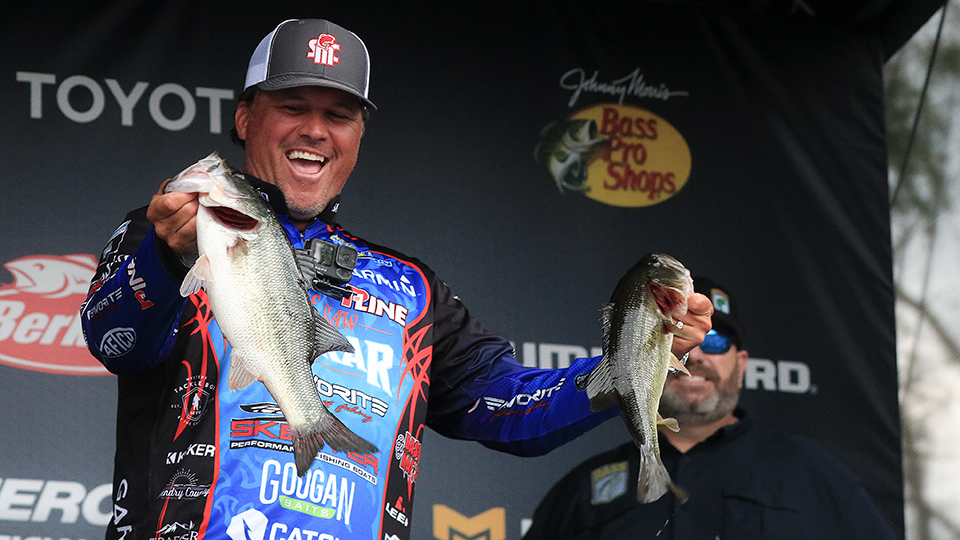
Even though I left the Santee Cooper Lakes with a lower finish than I wanted, I was thoroughly impressed with this amazing fishery. I think we hit it at the perfect time, and the weights reflected that.
This was my first time fishing the Santee Cooper Lakes, so there was an element of caution. I had heard a lot about how you can’t get out of the boat lanes, so I was a little apprehensive about running around everywhere.
Also, I didn’t know how this lake reacted to a spawn. What I mean is that, on some lakes they trickle in, but from what I saw on the water and on Bassmaster LIVE, these females moved in fast on Santee Cooper.
It also seemed the big fish were pretty easy to catch. On some lakes we go to, the sight fishing is there, but it’s extremely tough. The fish on Santee Cooper didn’t seem to be that way. If someone found a big fish, they caught it.
Obviously, sight fishing played a dominant role for Drew Cook and others in this tournament, and my game plan included an element of that. I’ve done a lot of sight fishing over the years, and I’ve won FLW events sight fishing. So I would have been very comfortable doing that, if I had made the cut.
My game plan was to fish the stained water on the upper end of Lake Marion where the water was a little warmer — it wasn’t as affected by the cold front that hit during practice. I figured those fish would stay better, and as the full moon approached, things would get even better.
It may have been a mistake, but I was actually envisioning a big wave of fish coming and that I would be flipping my bait up to cypress trees and catching 8-, 9- and 10-pounders. You know, kind of like what second-place finisher Caleb Kuphall did during the tournament.
When the cold front hit, it knocked fish in the lower end of Lake Marion completely off the bank. On the upper end — in The Swamp and Jack’s Creek where I was fishing — the water temperature didn’t fall as much. Those fish didn’t really pull off that much and practice was pretty good.
Now, fast forward to the tournament and the fish in that upper end stayed and kept spawning through the cold front. The water temperature didn’t drop to that critical level where it dropped them off.
Those fish kept progressing, and they finished their cycle, so by the time the tournament started, we were on the tail end of the spawn up there. They had cycled through their catchable period and turned into postspawn fish.
Those postspawn fish don’t weigh a lot, and it’s a depleted population. They’re not coming; they’re leaving. It all died off, and it was quite a shock.
My original game plan was to fish two days up north and then pivot on Day 3 and just sight fish down south in some areas I’d found in practice. I survived Day 1 with 17 pounds and was right on the bubble of an OK day. But I wanted to win. I wasn’t fishing for points. I was trying to be smart, and I think I kinda outsmarted myself.
I should have done what Matt Arey did — find some males and anticipate enough females pulling up throughout the first two days that you could ride it through the tournament. That worked out for him and, I believe, the majority of what the Top 10 anglers caught was stuff that just progressed throughout the tournament days.
I don’t know how I would have known that the fish up north were leaving, but that’s what happened. Just look at Jason Christie. He got tricked by it too, and he’s one of the best shallow water fishermen on the planet.
On Day 2, I pulled the plug on the northern areas after I had 13 1/2 to 14 pounds at 12:30. I was sure I could find one more big one down the lake. I’ve second guessed that decision a bunch. In fact, I got 10 miles down the lake and almost turned around and went back north because I needed one more good bite to make the cut.
So, do I run down south and try to catch a big spawner or two, or do I stay and try to find one more 4- to 4 1/2-pound fish up north? I was torn, but I left.
I think that was the right decision because for me to spend the last few hours up north trying to find another big fish was not as important as going down the lake, finding a couple big fish, catching them and then having a good idea of where to start on Day 3.
I actually found a 7-pounder at the lower end of Lake Marion, but I missed that opportunity and then time ran out and the day was over. In hindsight, I can see that I made several mistakes.
I didn’t recognize that the bite was going away. It’s a lesson learned, and that’s something to think about. But I still loved fishing the Santee Cooper Lakes, and I can’t wait to get another shot at this fishery.

